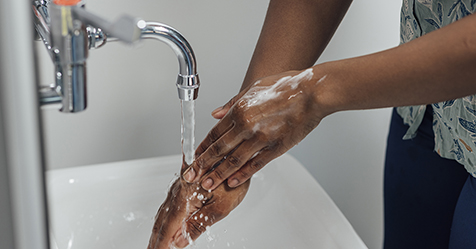There are some common myths in the cleaning industry that circulate because they may have been practiced in the past or because a product was promoted based on generalized misconceptions.
What follows are some of my favorite myths and misconceptions as they relate to hard floor care.
I am sure these will shock and amaze you, especially since these fables are often taken as commonsense industry knowledge.
1. The First Myth Of Floor Care: Sealers and finishes do the same thing, so only one of them is necessary
A floor sealer and a floor finish are not the same product.
A sealer will have a higher solids percentage — after evaporation, more polymers remain on the floor — than a finish, effectively filling pores and smoothing out inconsistencies in resilient tiles.
Sealers are used for building a base before you apply a finish and, given their high solids percentage, they exhibit little or no shine — a sealed, unfinished floor will have a dull or matte appearance.
Even though some tiles come with a factory-applied sealer, you must seal a floor before applying finish.
A high solids percentage in a floor finish does not make it a sealer; it does, however, mean it will be very difficult to remove when it comes time to strip.
2. The Second Myth Of Floor Care: A floor should be sealed after it has been stripped and refinished
Despite that it is an old idea and an outdated practice, I still see this mentioned in articles by floor care professionals.
Floors do not need to be sealed after stripping; resilient flooring needs to be sealed when it is first laid down.
Two to three coats of sealer should be applied, turning 90 degrees with each new coat — if you are going north-to-south when applying the first coat, apply the next in an east-to-west manner — then end with a final coat.
If done correctly and at the proper time, the floor will never need to be sealed again.
To prove this once you have stripped a floor bare, use a red pad and buff the bare floor, a mat shine will appear this is the sealer still in the floor.
If your floors are poorly stripped — there is often little time to complete floor care tasks and a small amount of old finish can remain — and then sealed, you will seal in the old, dirty finish, which makes the floor yellow faster and makes future restorative maintenance harder and more time-consuming.
3. The Third Myth Of Floor Care: A floor stripper can be applied and quickly mopped away
This myth actually contradicts the core cleaning principle of time, agitation, chemical and temperature (TACT).
First, the idea implies that you do not need dwell time and that you can just apply a product and then mop it off.
Second, it infers you don’t need to agitate the surface with a floor machine and a scrubbing/stripping pad.
If the stripper is so strong that you can mop it on and then easily mop it off, you either have very little finish left on your floor or your rubber boots will melt while you apply the solution.
All strippers need dwell time — surface contact upwards of 20 minutes in most cases — and you need to use a swing machine with an abrasive pad to effectively remove the floor finish.
I am sorry, but there are no shortcuts here, and a mop-on, mop-off floor stripper is about as real as a unicorn.
4. The Fourth Myth Of Floor Care: If a surface is considered no-wax flooring, it doesn’t need to be finished
Marmoleum, a type of linoleum flooring made of recycled materials, bonding agents, linseed oil and wood particulates, was and still is promoted as no-wax flooring.
The truth is that there is no such thing as a no-wax floor.
All resilient flooring needs a finish, as it protects the floor from damage.
Without finish, floors will wear and discolor more quickly and can be permanently damaged.
While resilient flooring of all kinds has a protective surface coating, it is a manufacturer’s coating applied at the factory and is only designed to prevent damage to tiles before they are installed.
When initially installed, resilient floors require a light scrub, the application of a sealer and at least three coats of finish.
5. The Fifth Myth Of Floor Care: Restorer can save you time and money
Remember back in the day when you or your coworkers would mix a 50/50 solution of finish and stripper in a spray bottle to spray buff the floor using a swing machine operating at 350 revolutions per minute (RPM)?
Before high-speed floor machines or ultra-high-speed (UHS) finishes, spray buffing was a common task.
Today, restoration finishes are essentially a waste of time and money.
Think about it: For the time it takes to mix your solution, apply the restorer and complete the spray buffing task, you might as well just refinish the floor with a top scrub and recoat.
6. The Sixth Myth Of Floor Care: Top scrubbing and stripping are one in the same
A common assumption made by custodians is that, because they used stripper when they scrubbed the floor, it is stripped.
In reality, however, the floor has not been stripped.
To strip a floor properly — to remove all of the finish down to the substrate — you need to leave the stripper on the floor for at least 20 minutes, agitating with a mop or other tool so it does not dry.
Then, after allowing the stripper to dwell, scrub it using a brown or black pad before picking up the slurry with a wet vacuum.
Now, the floor is ready to be rinsed and neutralized, which should be done a minimum of three times — more if all of the finish is not removed.
Simply using stripper and giving the floor a quick scrub and rinse is not considered stripping; said process is more akin to heavy-duty scrubbing or what is commonly called a top scrub.
7. The Seventh Myth Of Floor Care: There is no need for a neutralizer, especially since many offerings are now self-neutralizing
Because strippers and some heavy-duty cleaners are alkaline, you need to neutralize them using either a citric acid neutralizer or vinegar, which is acetic acid.
Even applying large amounts of water will simply dilute the alkaline; water will not neutralize an alkaline substance.
Without neutralization, floor finishes can react to the dry alkaline residue left behind and not adhere to the floor properly.
To reiterate: Water is not a replacement for a neutralizer, and even if you are using a self-neutralizing product, it is always a good idea to neutralize a floor after it is stripped.
8. The Eighth Myth Of Floor Care: Today’s floor finishes are fast drying and cure very quickly
Floor finishes dry from the bottom up; because of this, they require curing time.
No matter how quickly the finish may dry, and despite that is may feel dry to the touch, it is still wet as it soaks into the floor.
Although finishes dry faster today than they did in the past, allowing for more coats to be laid down in a shorter timeframe, it still takes a full 24 hours for a base coat to properly cure — possibly longer if more than four coats of finish were applied or if the humidity is high.
Because it dries from the bottom up, the more finish you apply, the longer the drying and curing time will be.
While the floor may be dry enough to walk on without marring, it will not be dry enough to put furniture or other heavy objects on for at least a day.
9. The Ninth Myth Of Floor Care: No-rinse chemicals can eliminate a step in the cleaning process
If you’re not rinsing, how exactly do you get rid of the dirt?
Again, this contradicts TACT; you cannot simply apply a cleaning chemical to a surface and expect it to work, which “no-rinse” suggests.
Agitation is still necessary, and after that is done, you have to wipe the surface clean — that is, remove the chemical you have applied with a mop, a squeegee, a vacuum or another similar method.
Since most cleaning chemicals or detergents are alkaline, they leave a residue on the surface that attracts dirt.
So, despite well-intended guidance from many, you still need to rinse a floor to remove any residual matter.
10. The Tenth Myth Of Floor Care: A wet/dry vacuum is a multiuse piece of equipment that can be used for nearly anything
A wet vacuum is a wet vacuum — period.
While wet/dry vacuums are sold as dual-purpose machines, the filters are made of muslin and require daily cleaning and frequent replacement.
Once used as a wet vacuum, the filter will not seal very well and can lead to unfiltered, dusty air billowing out of the exhaust when used again as a dry vacuum.
The filtration system of a wet/dry vacuum is for water weight suction rather than being a high-efficiency particulate air (HEPA) system.
Water suction is not the equivalent of dry vacuum suction with HEPA-filtered bags.
The suction of a wet/dry vacuum is significantly reduced when compared to dry-only canister vacuums.
11. The Eleventh Myth Of Floor Care: Feather dusters are useful for quick surface cleaning
Feather dusters are useless for cleaning; they simply spread around dust, dirt and bacteria that will need to be removed with future cleaning events.
And, while disposable or launderable static wipers do collect more particulates than a feather duster, they are not as effective as using either a dry microfiber cloth or a damp microfiber mop to remove surface dust.
The inadequacy of feather dusters has been known for over 100 years and is reflected in a quote from the 1913 book, School Janitors, Mothers and Health.
“Is the dust removed after the ‘dustless method’ necessary at home? If not, it is imperative to bring it about promptly. This means vigorous and faithful effort until feather dusters are replaced by cloths used so as not to scatter the dust, with open windows allowing as much as possible to blow out, and certainly not within one hour before the assembling of pupils,” exclaims Dr. Helen Putnam.
12. The Twelfth Myth Of Floor Care: Clean smells lemon fresh or has a piney musk
Clean has no smell; in actuality, clean is the absence of smell.
Malodors are caused by bacteria off-gassing, and the presence of odors is usually a sign of inadequate cleaning.
In order to eliminate odors, you need to remove all soils and biofilms by cleaning with a detergent and then kill the bacteria using a sanitizer or a disinfectant.
If you use bleach to “clean” and disinfect, you are not effectively doing either.
Instead, you are depositing volatile organic compounds (VOCs) into an area that compromise indoor air quality (IAQ) without achieving your desired outcome of a clean, hygienic surface.
Again, as Dr. Putnam noted a century ago, “Odors of disinfectants must not be accepted as proof of cleanliness. They merely disguise other odors, much like perfumes. Cleanliness has no odor.”


